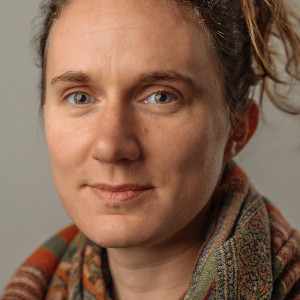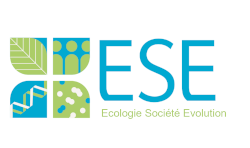
Blanche Collard
Position: Contractual lecturer and researcher
Team: Ecological Processes and human Impact
Contact details:
Laboratoire Écologie, Société et Évolution – IDEEV
Université Paris Saclay
Bât. 680 – 12, route 128
91190 Gif Sur Yvette
Tel: –
Fax: –
Email: blanche.collard (at) universite-paris-saclay.fr
Research interests
Key words: Agroecology, Urban ecology, Entomology, Ecosystem services, Biological control, Individual-based modelling, Penalised linear models, Entomology.
My research focuses on the interactions between human activities, ecological processes and biodiversity conservation. I am particularly interested in the possible synergies between food production and the maintenance of ecosystems that support a diversity and abundance of living organisms.
I – Towards a reduction in the use of pesticides in agriculture
During my first years of research, my work was essentially focused on reducing the use of pesticides in agriculture, by seeking to understand their use in France (Collard et al., 2020) and by looking for alternative methods of plant diversification inspired by agroecology.
I have been particularly interested in conservation biological control of pests in agriculture. While plant diversification often seems to increase the abundance and diversity of natural enemies of pests, its effect on their regulation and yield is mixed.
During my PhD, I explored the effect of the spatial organisation of habitats within the plot on conservation biological control. I showed that while increasing habitats could divert predators away from crops (Collard et al. 2022) and reduce their time spent searching for pests, it appears that certain habitat configurations can maximise the chances of predator-pest encounters, potentially mitigating the dilution effect inherent to the addition of habitat (Collard et al., 2018).
II – Dynamics of biodiversity and ecosystem services in urban and suburban environments
with E. Baudry, C. Bessa Gomes, C. Hanot, Q. Dutertre, M. Lachaise and M. Deparis Paris Saclay University, ESE)
Current urbanisation is considered to be one of the main causes of the decline in the diversity of many groups of living organisms. Within the PEPA team, we are seeking to understand how the diversity of living organisms and the associated ecosystem services are impacted by urban expansion and the intensity of urban human activities.
We are focusing in particular on urban vegetated spaces, which are key areas that can both support urban biodiversity and be a source of benefits for the mental and physical health of city dwellers.
Associated current research projects
GARLAND – Gardens as an opportunity for biodiversity conservation in peri-urban landscapes (coordinated by Emmanuelle Baudry).
In collaboration with S. Darly, R. Melot, G. Giacche and A. Mohamed (INRAE SADAPT), M. Riboulot-Chetrit (Panthéon-Sorbonne University, Geography)
- Gardener practices and diversity of plants and pollinating insects
With the GARLAND project in particular, we are focusing on domestic gardens, which account for a large proportion of the vegetated areas in cities and which are still little studied because they are difficult to access. The challenge is to identify the levers that can be used to maintain a greater diversity and abundance of living creatures in these gardens.
We are developing interdisciplinary approaches to study the garden socio-ecosystem as a whole. We are studying the gardener’s relationship with his or her garden by asking questions about motivations and objectives, and then about garden practices in terms of design and maintenance. At the same time, we carry out biodiversity inventories (spontaneous plants, cultivated plants and pollinating insects) to establish which practices are more favourable.
- Pollination and pest control services in urban and suburban environments
As well as understanding how human activities in the city impact urban biodiversity, we are also looking at the impact of this biodiversity on human activities. In particular, we want to understand how pollination and pest control services can be maintained in the urban environment, especially in domestic gardens.
I am particularly interested in the pest control service, for which the impact of the urban environment has been less studied than for the pollination service. We are also carrying out research using strawberry plants, grown in domestic gardens, to measure the pollination service.
- Combining the conservation of spontaneous biodiversity and vegetable production in home gardens
With urbanisation also putting pressure on professional and subsistence agricultural production, vegetated spaces are also an area of interest for urban agriculture. In recent years, numerous scientific studies have examined the role of urban agriculture in food security and the establishment of short supply chains, from the recycling of organic urban waste to local agricultural production.
We are asking to what extent these two objectives of agricultural production and conservation of urban biodiversity are reconcilable or contradictory. In home gardens in particular, we are looking at the role that the practice of vegetable gardening can play in the garden socio-ecosystem, both in terms of the motivations and practices of gardeners and in terms of biodiversity and ecosystem services in gardens.
Teaching
I teach mainly in Insect Ecology and Agroecology on issues relating to biodiversity conservation and pest control. In particular, I am co-responsible for UC1.11 ‘Issues and challenges of biocontrol’ for second-year students at Agroparistech.
Supervision
I am currently supervising with Emmanuelle Baudry two PhD students, Mathieu Lachaise and Quentin Dutertre, on the subject of biodiversity in domestic gardens.
Career path
See here.
Publications
PHD
Collard, B., 2019. Effet de l’organisation spatiale intra-parcellaire des habitats sur le contrôle biologique par conservation : étude et modélisation des déplacements de dermaptères dans les bananeraies. Université d’avignon et des Pays du Vaucluse, Avignon. https://hal.science/tel-02334234
Data
Tixier, P., 2018. Video monitoring data of earwigs Euborellia caraibea on residues and bare soil microcosms. https://doi.org/10.18167/DVN1/NPWMUP
